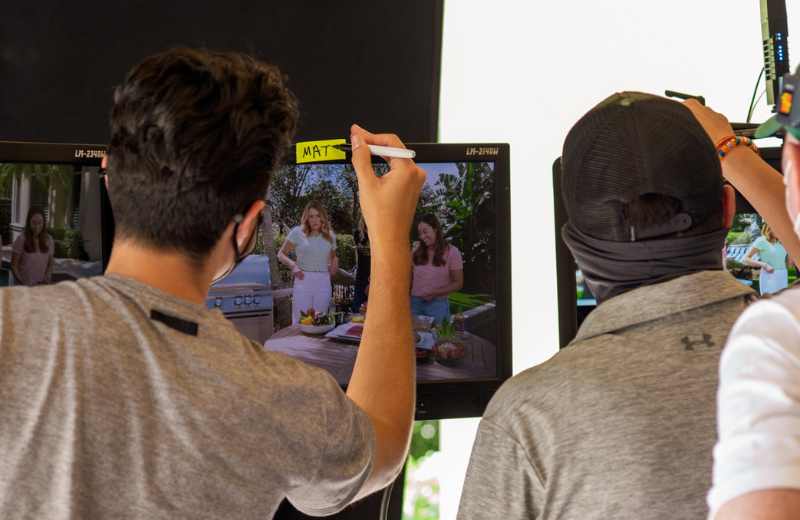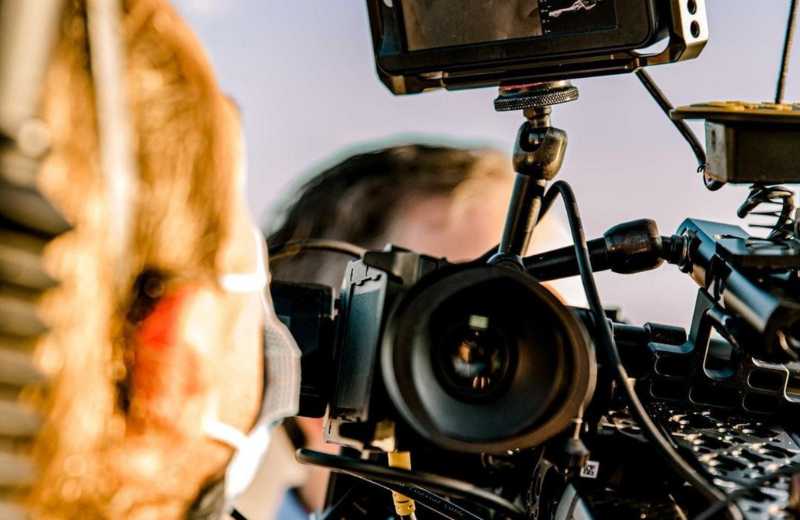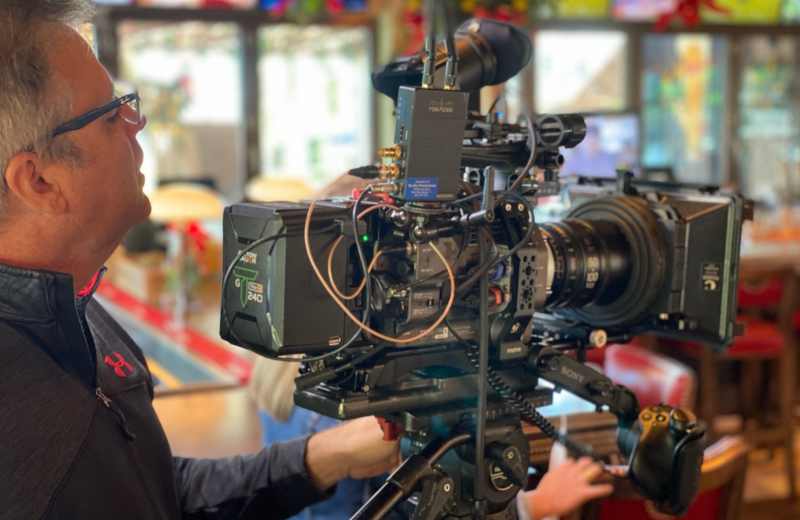Posted by Jim Gallagher
Why should you listen to me or waste your valuable time reading this blog about shooting a golf video? Humble brag time, I’ve directed and produced golf instruction videos with great players — Tiger Woods, Greg Norman, etc.– and 6 of the top 10 Teachers (Butch Harmon, David Leadbetter, Martin Hall etc.) in the latest Golf Digest Top 50 rankings, not to mention well over 100 Teachers and Coaches around the country. I’ve made my share of mistakes on golf video shoots and earned some hard-won lumps of knowledge.

1. Plan Out the Shoot
Every good video production begins with planning and logistics. There are fundamental questions that need to be answered.
Where are you shooting? On the course? Driving Range? Putting Green? Multiple Locations? What type of golf tip are you shooting? Full Swing? Short Game? Putting?
Once I know where we’re shooting and what type of golf video tips I’m directing, then we put together a shoot schedule. Moving a large or small crew takes time. You have cameras, audio, lighting, cables, generator, etc. that have to be set up and torn down every time you change locations. So, if you’re doing tips on the range and the subject is getting more distance from your driver, then don’t immediately schedule a bunker tip to follow. Maximize your time at each location. Simple but you’d be surprised how many times this doesn’t happen.
If at all possible scout the shooting location. This helps you pick out the best hole to shoot on, or which side of the range to shoot on. Planning your shots ahead makes for a better-looking video production and also doesn’t waste your talent’s time. No one wants to wait, but Superstars WILL NOT WAIT. So, plan ahead. Trust me – It pays off.

When shooting on course I try to find a hole that has the best combination of a good tee (good background, nice down line fairway shot, good grass), a good fairway bunker, nice green and bunkers. Perfect world if you’re shooting golf video tips that run the gamut from full swing to short game you are moving a short way and not all over the golf course. If you can’t scout the day before, then arrive early.
Know your weather and know your light. We live in Florida and in summer time it showers almost every afternoon, so we start early. If you’re shooting in Las Vegas, better shoot early or late — mid-day and the desert sun is directly overhead so shadows are terrible. In Monterrey, you have morning fog. Trust your DP, if he says the sun is bad from a certain angle, find another angle, or find another hole to shoot.
How does this all come together? We recently shot a series of golf tips with the ‘Shark” Greg Norman. He may be the most successful player to segue into the business world (Jack Nicklaus has done pretty well too!) with golf course design, a clothing line, wines etc. it’s not exaggerating that time is money when it comes to Greg. Full swing to the short game, we had to shoot a series of tips that encompassed every part of the game. We scouted ahead of time and found the perfect golf hole that had a nice-looking tee, good fairway bunker, thick rough, enough topography to showcase uphill and downhill lies and a green that had a clean opening to showcase pitch shots, good contours for putting and good bunkers.
We moved from tee to fairway to green efficiently and quickly and kept Greg’s valuable time on course to a minimum. When planning and logistics come together you can get a lot done in a short time. Helps if you have someone as good on camera as Greg Norman too!
2. Rehearse the Golf Instruction
This is one of the most important things to having a smooth video shoot. Have the golfer or teacher rehearse his or her golf tip. This accomplishes two important things:
(A) Let’s you know where you need to place your cameras. We’ll talk about camera angles next, but rehearsing the tip gives you and your Director of Photography a low-pressure chance to see the tip and talk it over the with golfer or teacher. Together you can figure out what cameras angles work best and more importantly be able to focus in on the key point or points of the tip. Many tips have 2-3 key points that really enhance the viewers understanding of the tip, so figuring out where to get your close-up shots and from what angle the tip needs to be shot are key.
The Golf Channel’s Martin Hall is an old friend, we’ve shot instructional golf videos with Martin on several occasions. He’s one of the best examples of rehearsing a tip and the crew being willing to take input from the teacher. Well before the Golf Channel, Martin knew what angles would be best for the particular tip he was doing or to showcase the prop he was using. It’s best when it’s a collaboration between the Director/Producer and the Teacher/Coach.
(B) Rehearsing also lets the teacher practice his on-camera performance. You’ll immediately know what type of on camera coaching he or she needs, and it serves to ease the subject into being on camera. It never takes more than a few seconds to see if a person is going to be at ease in front of a camera. If they are great, your job just got easier. Guys like Martin or Butch Harmon can roll out of bed and do a great golf tip, but that’s not always the case.
If they’re not experienced on-camera, then you need to help the person relax, give them some pointers on how to deliver the tip most effectively and encourage them to bring out their best. I’ve worked with total pros and absolute novices. They usually know their subject. That’s why they are being asked to do a golf tip, but often times they just need your help to bring out their best.
We recently shot more than 40 tips in a day and a half at the PGA Professional Championship in Monterey. All of the PGA Professionals knew their stuff, but their level of on-camera experience varied wildly. A quick rehearsal of the tip told me all I needed to know about how comfortable they were on camera and what camera angles we’d need. Perfect example would be Brian Fogt, the PGA Director of Instruction at Bellerive Country Club (Site of the 2018 PGA Championship). Brian had a great golf video tip for bunker play. We talked it over, rehearsed the tip and the end result was a terrific piece of instruction that I think will really help the average golfer with their bunker shots.
3. Camera Placement in Golf Videos
Your plan is in place and you have good weather so next step is where do you place your cameras? Generally, there are two must have angles for golf tips:
(A) Face On – Shoot directly facing the golfer
If the tip is on the grip, or posture, or ball placement, then your camera/cameras need to be Face on/Head On – Directly facing the golfer. This way you can have one camera shoot a wide shot that encompasses the entire body.
Key point – be wide enough to see the entire radius of the swing. Nothing looks worse than the club going out of frame! This camera can also shoot a tight shot of the key points of the tip. If it’s a tip on grip, have a tight shot of the golfers’ hands. It can also get a tighter shot of the Coach/Teacher doing the opening and closing portions of the tip. This tighter shot helps the viewer connect with the teacher.
This angle is extremely important for several reasons, but the most import is ball position. For instance, if you’re doing a video tip on hitting the ball off a downhill lie, then the ball position will be in the middle of the golfer stance. If the camera is not directly facing the Teacher/Coach, then it’s hard for the viewer to determine ball position, making it difficult for the viewer to then recreate this tip (Which is the whole point of doing a golf tip!). You can always get some snap zooms, extreme close-ups and quick cuts to have a hip modern feel, but you have to be head on as the basis for the tip.
Perfect example is a series of tips we shot for Golf Digest with the #1 Teacher in the world Butch Harmon.
(B) Down the Line – Shoot behind the golfer with the course or range in the background
If a tip is referencing swing plane, or club position in the backswing or the downswing this angle is essential. Again, getting a wide enough shot to see the entire golfer is key. You want to not only see the golf club in frame the entire time, but you want to be wide enough to see ball flight in many cases. If a tip is on hitting a fade or a draw, then you need to see the launch angle and the trajectory of the shot (Adding a shot tracer in post is a great visual aid on these types of tips). Down the line shots are essential in showing the viewer the path of the golf club.
Down the line is also a great way to show the viewer how to hit a particular shot when you’re doing a tip on the course. Recently we did a series of tips with one of the best young teachers in the game Jason Guss for Golf Digest. The theme of the tips was how to get out of trouble on the course. One tip had Jason off the fairway, ball behind a tree. Watch how the down-the-line angle showcases the various options and ways to get out of trouble.
You can also pick up tight shots to really emphasize a particular part of the tip to the viewer. Shooting in 4k and now 8k on some cameras, gives you the ability in post-production to digitally zoom in on many cases. Thus, not having to make the golfer do a pick-up shot. Though I’ve come across very few Pro’s who can’t recreate a club’s position within almost a millimeter if you need to do a pick-up take for a tighter angle shooting in HD.
Why are camera angles so important?
A few years ago, we hired to work with Tiger Woods on a series of short game tips. Why did we get hired to do these tips? Well a previous production company did them once before us. They looked great, well shot, good lighting, they used high end cameras etc. This production company was obviously a very talented group. So, what was the problem? In two words: Camera placement. The cameras were slightly off center on almost every shot, cool looking angles, but when watched for content it was extremely tough for a viewer to know exactly where Tiger was emphasizing his club or ball position. On one tip Tiger mentioned taking the club back on plane, good advice. Except instead of a down the line angle, the camera angle was off to the side. Looked nice, but totally unusable as a teaching tool for the viewer.
I hope these three tips help you. My hope is these suggestions will help you shoot better golf instruction either professionally or as an amateur golfer filming your own swing with your iPhone (The newer phones shoot 4k at 120 frames a second!) to improve your game. Thanks so much for taking the time!
Click here to see more video samples of our work.




